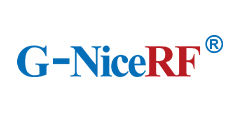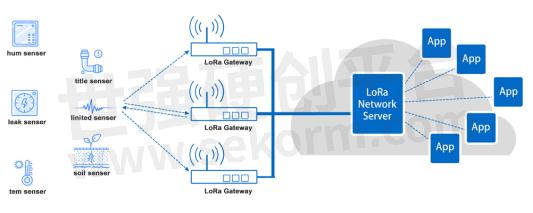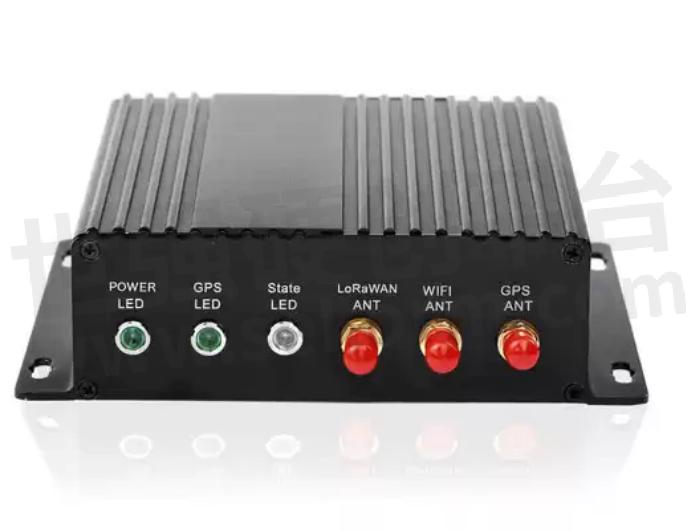LoRaWAN Network Protocol Defines Three Operational Modes: Class A, Class B, and Class C




LoRaWAN is a low-power wide-area network protocol designed specifically for wide-area IoT applications. It is particularly suitable for IoT devices, enabling long-range communication at low data rates. The LoRaWAN network consists of multiple components, including nodes (end devices), gateways, and network servers. In the LoRaWAN network protocol, LoRa refers to the physical layer modulation technology, while LoRaWAN defines the rules and data formats for communication between devices.

The three working modes of LoRaWAN
The LoRaWAN protocol primarily defines the communication of IoT devices in low-power wide-area networks. It features three working modes: Class A, Class B, and Class C, each differing in power consumption, latency, and communication frequency to accommodate various application needs.
Class A Mode: Class A mode is the lowest power consumption mode and the basic mode for LoRaWAN devices. Devices can transmit data to the gateway at any time. After transmitting data, the device opens two temporary windows to receive the transmitted data. If no data is received in these windows, it waits until the next data transmission. Devices in Class A mode spend most of their time in a sleep state, consuming power only during data transmission and reception windows. This mode is suitable for applications with infrequent communication needs, such as environmental monitoring sensors.
Class B Mode: Building upon Class A, Class B mode introduces synchronized slots, allowing devices to open receive windows at scheduled times for gateway-initiated downlink transmissions. Devices periodically receive synchronization signals from the gateway, enabling them to open additional receive windows at specified intervals. This mode consumes slightly more power than Class A because devices need to periodically receive synchronization signals and open receive windows at scheduled times. It is suitable for applications requiring periodic communication or lower latency.
Class C Mode: Class C mode offers the lowest latency but consumes more power, suitable for applications requiring real-time communication or continuous monitoring. Devices can transmit data at any time and immediately switch to receive mode after transmission. Devices remain in receive mode almost constantly, closing the receive window only when transmitting data. Due to the constant receive state, this mode consumes more power and is suitable for devices with continuous power supply. It is ideal for applications needing frequent communication or low latency, such as industrial monitoring and smart lighting systems.

NiceRF LoRaWAN gateway
LG1301-PF is a LoRaWAN gateway. It can be used with any LoRaWAN nodes compliant with the standard LoRaWAN protocol V1.0. The gateway is hosted on a Linux platform and consists primarily of a concentrator, GPS module, WiFi, and Ethernet. The GPS module sends NMEA frames containing time and geographic coordinate data to the host. Additionally, the GPS module outputs a pulse to the sx1301 every second. The gateway receives RF data from nodes and forwards it to the server. It also receives data from the server and transmits it to the nodes. The gateway connects to the server via Ethernet or WiFi.
LN610 is a LoRaWAN node module. LG1301-PF/LG1301-SE are LoRaWAN gateways. LN610, together with LG1301, forms a LoRaWAN system. This LoRaWAN system integrates LoRaWAN V1.0 protocol and supports Class C. When data is input to LN610, LN610 transfers the data to LG1301. Upon receiving data from LG1301, LN610 outputs the received data through serial interfaces. All wireless communications adhere to the LoRaWAN protocol.
LG1301-PF or LG1301-SE can be used in conjunction with LN610.

LG1301-PF Features
LoRaWAN protocol supported
Uart interface
AES128 encryption
8 channel communication simultaneously
Configurable parameters
GPS support
Long range
EU433M / EU868M / KR920M / AS923M / CN780M/ CN470M / US915M / AS915M
Application
Smart city
Smart Metering ( Water, Electric, Gas meter )
Agricultural Monitoring
Irrigation control
Internet of Things (IoT)
M2M
Wireless Sensors
Wireless Alarm and Security Systems
- |
- +1 赞 0
- 收藏
- 评论 0
本文由玄子转载自G-NiceRF Official Website,原文标题为:LoRaWAN network protocol defines three operational modes: Class A, Class B, and Class C,本站所有转载文章系出于传递更多信息之目的,且明确注明来源,不希望被转载的媒体或个人可与我们联系,我们将立即进行删除处理。
相关推荐
LoRaWAN网络协议Class A/Class B/Class C三种工作模式说明
LoRaWAN是一种专为广域物联网设计的低功耗广域网络协议。它特别适用于物联网(IoT)设备,可以在低数据速率下进行长距离通信。LoRaWAN网络由多个组成部分构成,其中包括节点(终端设备)、网关和网络服务器。LoRaWAN网络协议中LoRa是物理层的调制技术,而LoRaWAN是网络层协议,定义了设备间通信的规则和数据格式。
技术探讨 发布时间 : 2024-08-08
Data Security and Precision Control: Precision Application of Smart Irrigation Using LoRa Technology and LoRaWAN Gateway
This article introduces the application characteristics of LoRa modules in smart irrigation technology, how the LoRa modules achieve precision irrigation in smart irrigation and the functions of the LoRaWAN Gateway LG1301-PF in smart irrigation systems.
技术探讨 发布时间 : 2024-08-07
LoRaWAN网关是什么?
LoRaWAN网关是LoRaWAN物联网架构中的一个核心硬件组件,通过它可以从设备收集数据并将其转发至网络服务器。一个LoRaWAN网关主要由两个组件构成:主机和集中器。本文对其介绍。
技术探讨 发布时间 : 2024-07-04
安信可科技(Ai-Thinker)物联网专用模组&天线选型指南
目录- LoRa product Radar product WiFi+Bluetooth products 2.4G Series Module GPS Series Module UWB & 4G series module GPRS series module Offline Voice Module Series Antenna
型号- RA-01SH,PB-02-KIT,RTL8720 SERIES,AI-WB1,AI-WB2,AI-WB2-M1,HI-07S-KIT,TB-02-KIT,AI-WB2-12F-KIT,AI-WB2-13-KIT,AI-WB2-13U,AI-WB2-01S,A9,SX1268,RA-01SC,TG-02-KIT,PB SERIES,RTL8710BX SERIES,GPS SERIES,AI-WB2-01M,VC-01-KIT,HI-12F,TB SERIES,HI-12F-KIT,BW16,AI-WB2 SERIES,BW15,BW14,TG-12F-KIT,BW12,RTL8710BX,A9G,HI SERIES,AI-WB2-12S,PB-03,SX126X,AI-WB1-32S,HI-07S,HI-07SL-KIT,PB-01,PB-02,RG-02,AI-WB1-32S-KIT,RTL8720DN,AI-WB2-12F,TG-01M,AI-WB1SERIES,NF-05,NF-02-PA,NF-04,NF-03,BW16-KIT,NF-01-S,SX127X,TB-03F-KIT,LLCC68,TG-02,AI-WB2-07S,NF-01-N,NF-02-PE,AI-WB1-32S-CAM,GP-02-KIT,AI-WB2-M1-I,TG-02M-KIT,TG-02M,RA-08-KIT,GP-01,GP-02,CA-01-KITC,CA-01,2.4G SERIES,AI-WB2-13,PB-03F,PB-03M,TG SERIES,TB-04-KIT,TB-05,GPRS SERIES,TB-04,TG-02F,TB-02,RTL8720DN SERIES,TG-02F-KIT,4G SERIES,PB-03M-KIT,AI-WB2-32S-KIT,BU01,RA-01,PB-03-KIT,ESP32-G,RTL8720,RA-08H,NF-04-MI,VC-02-KIT,NF-05-S,RA-01S,HI-12FL,RA-01H,HI-07SL,AI-WB2-32S,RA-01SCH,PB-01-KIT,RTL8720CF,TG-01M-KIT,TG-12F,AI-WB1-A1S,AI-WB1-12F,TB-03F,BW15-KIT,GPRS,UWB SERIES,GP-01-KIT,AI-WB1-12F-KIT,NODEMCU-BU01,RA-08H-KIT,RD-01,RA-02,RTL8720CF SERIES,RA-08,VC-02,VC-01,HI-12FL-KIT,PB-03F-KIT
思为无线LoRa模块类别说明及应用选择
LoRa模块因其低功耗和长距离通信的特点在物联网应用中广受欢迎。那LoRa模块能具体从事哪些领域,有哪些具体应用呢?以下就以思为无线的LoRa模块给大家举例说明一下。
产品 发布时间 : 2024-09-21
LG1301-SE、LG1301-PF和LoRaWAN1301三款LoRaWAN网关模快的区别是什么?
本文介绍思为无线推出的LG1301-SE、LG1301-PF和LoRaWAN1301三款LoRaWAN网关产品以及它们之间的区别是什么。目的是让广大客户能够区分这三款产品,选购最适合自己的LoRaWAN网关产品。
产品 发布时间 : 2024-07-19
思为无线LoraWAN网关LG1301-PF,支持同时多达8个通道的通信,实现智能灌溉的精准化应用
思为无线LoRa网关设备实时连接灌溉现场的传感器设备(温度、湿度传感器、光照传感器、二氧化碳传感器等等)实时采集设备数据并通过LoRa模块定时上传到云平台或本地上位机,实现远程监控、故障报警、设备管理等功能,为灌溉策略调整提供科学可靠的数据支持。
应用方案 发布时间 : 2024-09-04
Characteristics and Advantages of LoRa Gateway + LoRa Nodes
A LoRa node is a wireless terminal device connected to the LoRaWAN network. They can be various types of devices such as sensors, switches, alarms, etc. These nodes transmit data to the cloud or other servers through the LoRaWAN network. A LoRa gateway acts as a bridge between the nodes and the cloud. It receives data from the nodes and transmits it to the LoRaWAN network. Additionally, the gateway can receive instructions from the network and transmit them back to the nodes.
技术探讨 发布时间 : 2024-05-21
Sentrius™ RG191+LTE Gateways
型号- RM1XX,SENTRIUS™ RG191,450-00107-K1,EG91-NA,QCA6004,SENTRIUS™ RG191+LTE,SX1301,SX1257,RS1XX,450-00109-K1,690-1002,690-1003
Sentrius RG1xx Gateways LoRaWAN-enabled with 802.11a/b/g/n Wi-Fi and BT 4.0 Product Brief
型号- 455-00054,455-00055,455-00028,455-00056,455-00057,RG191,450-0190,450-0191,RG1XX,SX1301,SX1257,690-1002,RG186,690-1003
电子商城
服务
支持 3Hz ~ 26.5GHz射频信号中心频率测试;9kHz ~ 3GHz频率范围内Wi-SUN、lora、zigbee、ble和Sub-G 灵敏度测量与测试,天线阻抗测量与匹配电路调试服务。支持到场/视频直播测试,资深专家全程指导。
实验室地址: 深圳/苏州 提交需求>
Ignion可支持多协议、宽频段的物联网天线方案设计,协议:Wi-Fi、Bluetooth、UWB、Lora、Zigbee、2G、3G、4G、5G、CBRS、GNSS、GSM、LTE-M、NB-IoT等,频段范围:400MHz~10600MHz。
最小起订量: 2500 提交需求>


























































































































































































登录 | 立即注册
提交评论